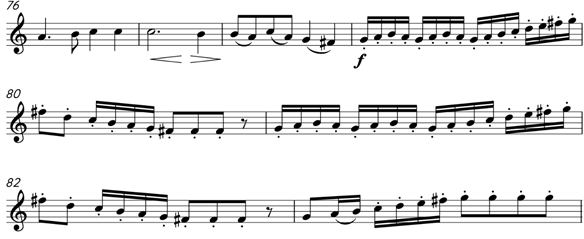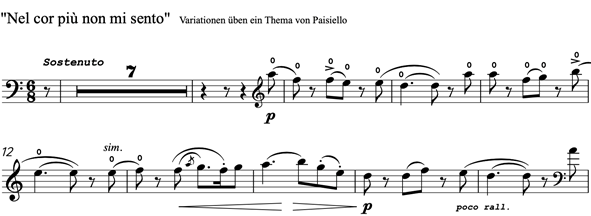Volume 16, October 2022
A Technical Guidance for the Dragonetti Concerto In A Major By Édouard Nanny and Beyond
by Irmak Sabuncu
6. Further Utilization Beyond Dragonetti
The chapters "Bow Stroke Types in the Piece and Suggestions" and "Thumb Position" contain exercises tailored for left-right hand coordination, slurred and detaché sixteenth-note and triplets playing, and recommendations for playing in thumb position (Exercises 1-7 and Example 3, Picture 1-6). These serve as preparatory drills for passages like the following section from J. M. Sperger Double Bass Concerto No: 1510 first movement.
Example 10. J. M. Sperger, Concerto No: 15, mm. 76-83
The preparatory exercises and guidance for the vertical execution of the harmonic arpeggio movements and the horizontal lyrical playing on the harmonics are presented under the chapter "Harmonics" (Exercises 11-18). Although the suggestions and exercises aimed to approach Dragonetti's A Major concerto's specific sections, it is possible to come across similar passages in many works written for double bass, especially in the works written by G. Bottesini. In this context, the recommendations presented in this section shall contribute to the player's technical skills as a preliminary preparation for the specific sections from "Nel core piu non mi sento" by G. Bottesini11 and similar challenges.
Example 11. G. Bottesini, "Nel cor più non mi sento", mm. 9-16
Example 11. G. Bottesini, "Nel cor più non mi sento", mm. 107-110
Arpeggio passages embellished by neighboring chromatic notes (mentioned under the Chapter "Intonation and Shifting") are often encountered in string literature. The suggested method of practicing only the main notes of the arpeggio without the surrounding chromatic embellishment is also applicable for the following three sections of the first movement of the Koussevitzky F# minor Concerto12.
Example 12. Koussevitzky, Concerto in F# minor, 1, mm. 61-62
Example 13. Koussevitzky, Concerto in F# minor, 1, mm. 65
Example 14. Koussevitzky, Concerto in F# minor, 1, mm. 67
|






